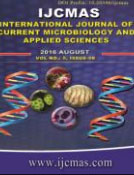


 National Academy of Agricultural Sciences (NAAS)
National Academy of Agricultural Sciences (NAAS)

|
PRINT ISSN : 2319-7692
Online ISSN : 2319-7706 Issues : 12 per year Publisher : Excellent Publishers Email : editorijcmas@gmail.com / submit@ijcmas.com Editor-in-chief: Dr.M.Prakash Index Copernicus ICV 2018: 95.39 NAAS RATING 2020: 5.38 |
Neonatal sepsis is an important cause of mortality and morbidity in infants. This prospective study was done in a tertiary care hospital involving 65 neonates to study the microbiological profile of neonatal sepsis and to prove that umbilical sepsis is one of the important predisposing factors for neonatal sepsis. Premature rupture of membranes was the predominant maternal risk factor and preterm and low birth weight babies were important neonatal risk factors. Umbilical swab culture and Blood culture were performed for all neonates with various clinical manifestations of sepsis including signs and symptoms specific for umbilical infections (Omphalitis). The commonest organisms isolated from umbilical swab culture were Coagulase negative Staphylococci in 7 (35%), Klebsiella pneumoniae in 5 (25%), Escherichia coli in 3 (15%), Staphylococcus aureus in 3 (15%), Citrobacter freundii in 1 (5%) and Acinetobacter species in 1(5%). In 6 cases of septicemia, 3 cases with Klebsiella pneumoniae and 3 cases with Coagulase negative staphylococci, the same organisms were isolated in umbilical pus and blood suggesting that umbilical colonization had led to septicemia. Gram positive organisms were more susceptible to Linezolid, Vancomycin Cefrtriaxone and Ofloxacin. Gram negative organisms were more susceptible to Cefaperazone/ sulbactam Piperacillin/Tazobactam and ofloxacin. Implementation of preventive strategies, as well as early and accurate diagnosis, and appropriate therapeutic management for newborns with umbilical infection with and without sepsis are essentially needed for developing countries.
 |
 |
 |
 |
 |